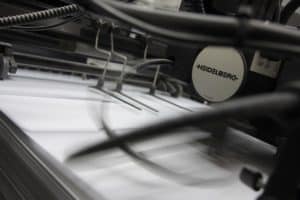The main benefits of using composite blades in printing are increased strength and weight, noise reduction, and improved color consistency.
Increased strength
Composite blades are commonly formed from a laminate structure containing multiple layers of composite material and fibrous reinforcement layers. The layers are arranged in alternating layers, with the reinforcement layers forming the outer and core layers. The reinforcement layers are typically composed of fiberglass fabric. The fibers used are preferably woven together and are arranged in the cross-machine direction (arrow 20 in FIG. 1). Although composite blades have a higher wear rate than metal blades, the material is generally less abrasive to the roll surface, thereby reducing the need for maintenance.

This material can resist high temperatures. In addition to reducing the wear and tear of the edge, it can be manufactured at high precision. In this way, it can be used to produce high-performance turbine blades.
Lower weight
Composite printing blades are often made of a composite material. These materials contain alternating hard and soft layers that act as abrasive surfaces. Composite material has a higher surface area than other materials, but its weight is lower. These advantages are significant for applications that require a highly abrasive blade.
Composites also have a high strength-to-weight ratio. For example, carbon fiber is 70 percent stronger per pound than aluminum. These factors help explain why high-end auto engineers use composites in vehicles. They can reduce the weight of a car by up to 60 percent while improving crash safety. These materials also resist heat and shrinkage, making them great for manufacturing applications.
These advantages are even more apparent in composite rotor blades. These rotor blades are made of hundreds of layers, which makes them extremely complex to design. Moreover, they can be made of different cross-sections, thicknesses, and inclination angles. Minor changes to a blade’s shape can significantly affect its performance. Fortunately, there are ways to solve these problems using advanced modeling software.
Improved color consistency
The improved color consistency of composite blades for printing is the result of developing new technology. Another advantage is the reduced time required for bedding-in, which means less downtime.
The newest generation of composite printing blades has improved seals and chamber sealing. These features enable a consistent final product.
Reduced noise
The noise reduction system uses structures placed on both face sheets of a composite panel. These structures reduce the speed of sound propagation through the composite board.
The design of the blades should have various characteristics to minimize noise and improve efficiency. For example, the outer blade shell should resist cooling and dirt. It also needs to achieve high aerodynamic performance under different weather conditions. This is possible with an optimized blade shape. This design may also reduce noise.
Bio-inspired blades have been shown to reduce noise by up to 50 percent. They can also reduce the noise of drones by up to 10 dB. This method is patent-pending and is an innovative solution to a longstanding problem. The disadvantages of bio-inspired blades are that they are very costly to produce, require a large amount of labor, and often end up in landfills.
Pareto-optimal solution
A Pareto-optimal solution is designed with the optimum combination of stiffness and mass. It has optimal ribs and shear webs and is distributed uniformly over the blade span. Its design aims to maximize aerodynamic performance under a range of weather conditions.
The proposed design involves a sandwich structure with composite face sheets and a weak honeycomb aluminum core. The overall thickness of the blade is held constant. The core thickness is varied within upper and lower bounds. The optimum design is also subject to radial displacement and ply failure strength constraints. Finally, the number of plies is calculated.
The Pareto-optimal solution reduces blade tip displacement by 15%, despite the increased mass of the blade. This is because the blade group is related to the structure’s stiffness. The optimal design also increased the 1st natural frequency by 1%. The second and fourth natural frequencies increased by 8.2%.
